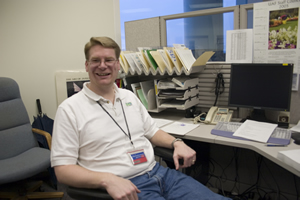Alaskan to sit on Cray supercomputer group international board
Alaskan to sit on Cray supercomputer group international board
Submitted by Debra Damron
Phone: 907-452-8662
06/26/08

Liam Forbes, a high-performance computing analyst with the Arctic Region Supercomputing Center and a former top-place finisher as a UAF student in the international Mathematical Contest in Modeling, is now a member of the board for the association of users and organizations around the world that own Cray Inc. computer systems.
During the annual Cray Users Group meeting in Helsinki in May, Forbes was elected Director-at-Large, Americas.
"Liam’s seat on the board further cements ARSC’s strong national and international reputation for the high quality of performance and knowledge we have among our peers in the field of high-performance computing," said Barbara Horner-Miller, associate ARSC director and general chair for the Supercomputing Conference 2006, a meeting on high-performance computing, networking, storage and computational science in Tampa, Fla. which drew thousands of participants.
ARSC maintains a very significant presence in the HPC community by holding top leadership positions in national and international organizations including Cray Users Group, Supercomputing Conference, the Coalition for Academic Scientific Computation, the IBM Big System User Group and the Open Grid Forum.
Cray Users Group is an independent corporation, not an appendage of Cray Inc., says Horner-Miller, who has served in the group’s leadership positions for more than a decade.
"The benefit of our active participation is that we have a place at the table to give and take support from fellow members as well as to influence those who sell HPC systems to act in ways that benefit HPC users," she said.
ARSC is the sole provider of open research computing capabilities for the Defense Department’s HPC Modernization Program. As a shared resource center, ARSC serves both academic and agency interests.
Forbes has been affiliated with UAF since 1991. He earned a bachelor’s degree in computer science in 1995, the same year a paper he co-authored earned the highest ranking in the Society for Industrial and Applied Mathematics international Mathematical Contest in Modeling. In 1998, he received his master’s degree in computer science from UAF. He joined ARSC in 1995 as a student research assistant and became a full-time staff person in 1996.
"Working at ARSC has given me a great opportunity to advance my knowledge in computer security, advanced programming and high-performance computing hardware," Forbes said. "It’s a great honor to serve on the [Cray Users Group] board and I’m looking forward to representing ARSC and the university in the organization. It’s particularly timely given the acquisition of Pingo, a 3,456 processor Cray XT5, which we expect to be operational some time this fall," he said.
ARSC has a history of naming supercomputing systems with Alaska or Arctic themes. A pingo is an earth-covered ice hill formed by the upward expansion of underground ice. ARSC’s first supercomputer, a 4-processor Cray Y-MP named Denali, came online in 1993. At that time, a Cray was considered the fastest supercomputer in the world. Denali retired in 1998.
The new Cray XT5 will replace Iceberg, ARSC’s 800 processor IBM Power 4+ supercomputer. Iceberg has served ARSC users well and performed in an outstanding manner, and will be retired in July 2008. Pingo is slated for installation at the end of the summer, with early user access anticipated in October. Users will have full access to Midnight, ARSC’s 2,312 processor Sun Opteron cluster, during the time the new Cray XT5 is installed.
Pingo will allow ARSC to expand atmospheric studies that include forecasting space weather’s impact on worldwide communications and radar systems, as well as providing optimal, arctic-specific, high-resolution Earth weather forecasts to include smoke dispersion from wildfires.
A global community of researchers uses supercomputing resources at ARSC. Projects include study of the world’s oceans, which consists of creating models that predict the force and direction of tsunami waves or the potential for ice-free summers in the Arctic.
Studies of atmospheric phenomena include development of accurate and reliable modeling of the influence of weather on volcanic ash transport, which has an immediate impact on aircraft flying northern polar routes and the health and safety of those on the ground.
CONTACT: Liam Forbes, HPC analyst ARSC, at 907-450-8618, lforbes@arsc.edu. Debra Damron, communications director, ARSC, at 907-450-8662, damron@arsc.edu.


